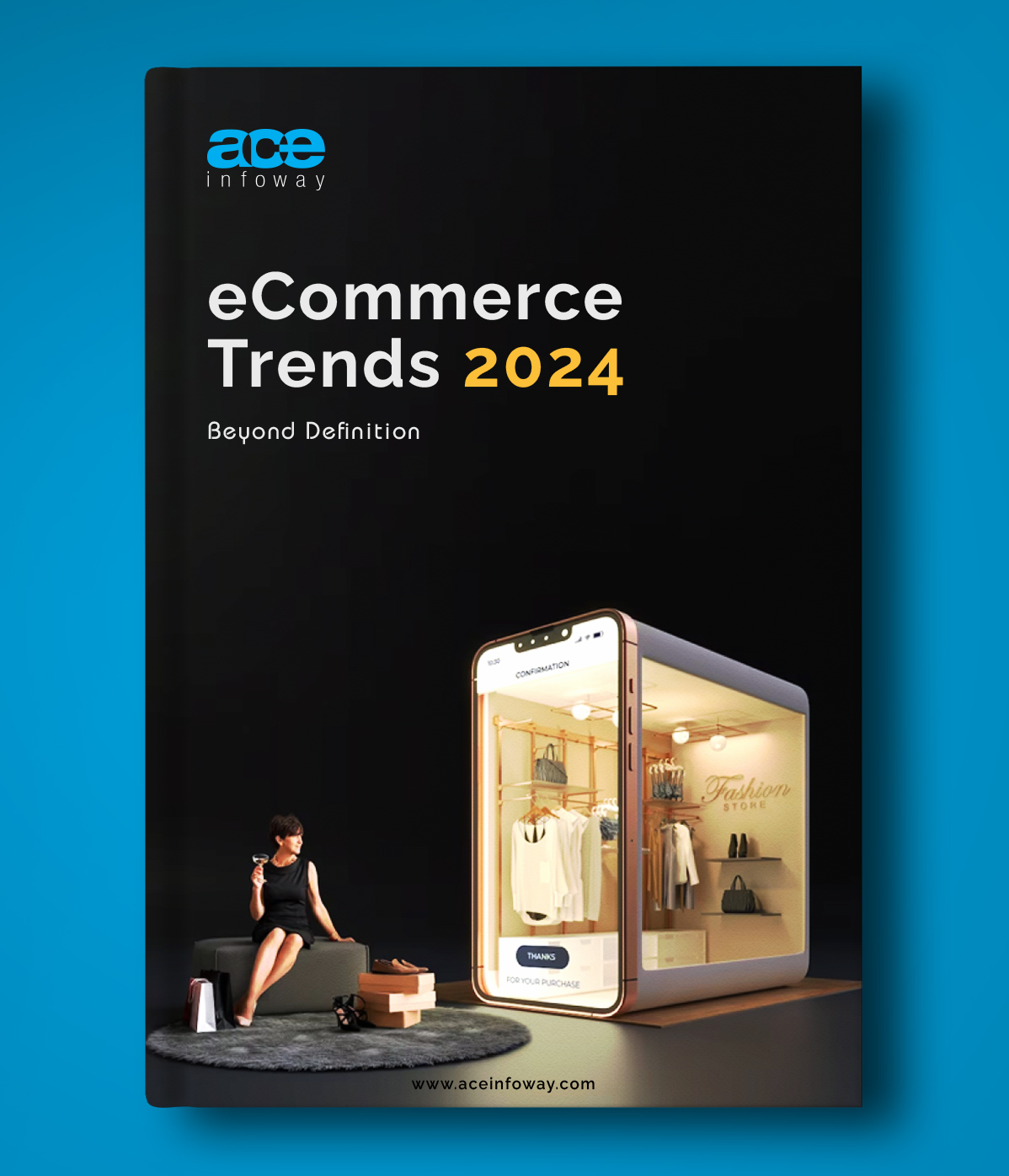Table of Contents
In the year 2024, online transactions will make up a substantial 21.2% share of the overall retail sales landscape as per Insider Intelligence Report. This indicates a significant shift in consumer behavior towards digital commerce channels, underscoring the increasing prominence of online platforms in the retail sector.
The implications of this projection extend to various aspects of the retail industry, influencing strategies, technological investments, and customer experience enhancements as businesses adapt to the evolving preferences and habits of the modern consumer.

Top eCommerce Trends to Shape the Future in 2024
Get your free copy
Let’s examine how the foremost eCommerce trends are influencing the future in 2024.
Top 7 Trends to Check for 2024
- AI & ML
- Voice-Activated Shopping
- Social Commerce
- Same-day Delivery
- Environmental Consciousness
- Short-Form Video
- Direct Messages (DMs)
1) AI & ML Enhancing Customer Personalization
AI-powered personalization is precisely employing advanced algorithms to sift through extensive customer data and deliver information tailored to your unique behavior. With a growing expectation for advanced personalization among consumers, eCommerce brands have multiple avenues to leverage AI in providing tailored shopping experiences.
Here are some effective approaches:
- Personalized Product Picks: AI-driven personalization, exemplified by customized product recommendations, relies on sophisticated machine learning algorithms that analyze customer data such as previous purchases, cart additions, reviews, and interactions. These algorithms continuously learn and enhance recommendation accuracy with new data.Example: Netflix pioneers recommendations through its NRE (Netflix Recommendation Engine), utilizing algorithms to analyze viewing history and provide hyper-personalized movie and TV show suggestions.
- Automated Dynamic Pricing: Machine learning empowers eCommerce brands to efficiently adjust prices in real-time based on factors such as manufacturing costs, competitor pricing, market demand, and seasonality.Example: As the AI pricing leader, Amazon employs machine learning to dynamically adjust millions of product prices daily, considering factors like demand, stock levels, and customer behavior, ensuring consistently competitive pricing.
- Modern Chatbots: By integrating sentiment analysis with customer data and providing swift responses, chatbots have evolved into personalized assistants. They are capable of greeting customers by name, suggesting tailored products and discounts, and facilitating online purchases.Example: eCommerce chatbots like Sephora’s transcend basic inquiries to serve as virtual shopping assistants.

2) The Rise of Voice-Activated Shopping
Voice-activated shopping, also known as Voice Commerce, represents an advanced integration of tools and systems designed to empower online shoppers to interact with and make purchases of products or services through spoken commands.
Implementing successful voice-activated shopping involves adopting key practices to optimize user experience and achieve desired outcomes.
- Optimize for Voice Search: When optimizing for voice search, it’s crucial to align voice commerce items with relevant keywords for search engines like Google. This can be achieved by incorporating long-tail, conversational keywords to enhance visibility and ensure that your products are easily discoverable through voice commands.
- Craft Voice-Friendly Content: Creating content that resonates with voice assistants is essential. Ensure that your content is easily understood by these digital assistants, and infuse a conversational tone by using colloquial language. This approach makes your content more engaging and accessible through voice commands.
- Enable Voice-Activated Shopping: To facilitate voice-activated shopping, it’s important to allow purchases through voice commands. Additionally, streamline the checkout process to optimize efficiency, making the shopping experience seamless and user-friendly for customers utilizing voice interactions.
- Offer Voice-Based Customer Support: Enhance customer support by extending assistance through voice assistants or chatbots. This not only provides a convenient option for customers seeking help but also empowers them to access information using their voice, contributing to an overall improved support experience.
- Track Voice Commerce Performance: Tracking the performance of voice commerce is essential for evaluating the effectiveness of your strategy. Establish measurable indicators for voice searches, purchases, and support requests. Align these benchmarks with your overall company goals to ensure that your voice-activated shopping initiatives contribute to your business objectives.
- Implement Customer Insights: Utilize tools like Bazaarvoice’s Insights and Reports to gain valuable customer insights. Transform user-generated content into actionable data that informs your eCommerce strategy. By understanding customer preferences and behaviors, you can refine your approach and enhance the overall effectiveness of your voice-activated shopping features.

3) Capitalizing on the Power of Social Commerce
Social platforms act as the primary entry point for numerous individuals, serving as the gateway to their online pursuits encompassing news, entertainment, and communication. This paradigm shift is fundamentally altering the way people interact online and conduct their shopping activities, amplifying the influence of social platforms on the overall commerce experience.
Social commerce can be implemented through three primary approaches:
- Content-Driven: Engage in authentic discovery by creating unique content on platforms like Pinterest, TikTok, and Instagram. This method involves leveraging compelling content to showcase products or services, thereby encouraging user engagement and facilitating purchases.
- Experience-Driven: Integrate shopping seamlessly into various experiences, such as live streaming sessions or augmented reality/virtual reality (AR/VR) environments. By embedding commerce functionalities within interactive and immersive experiences, businesses can enhance customer engagement and make the shopping process more dynamic and enjoyable.
- Network-Driven: Harness the power of social networks for buying and selling activities. This includes initiatives like group purchases for discounted rates and collaborations with influencers who play a pivotal role in driving sales. Influencers, in particular, can earn commissions, creating a symbiotic relationship between social network users and those promoting products or services. This network-driven approach utilizes the social fabric of online communities to foster commerce interactions and transactions.

4) Same-day Delivery for Speed and Convenience
Consumer preferences lean towards convenience. The introduction of same-day delivery enriches the customer experience, providing a delivery choice that aligns seamlessly with their preferences and expectations, ultimately elevating overall satisfaction levels.
Consider these factors carefully before aiming to become a trend in the industry:
- Ensure Timely Fulfillment to Meet Delivery Timelines: It’s crucial to guarantee that orders are processed and fulfilled promptly to meet the specified delivery timelines. Timely fulfillment is essential for customer satisfaction and maintaining a positive reputation, especially in the context of meeting promised delivery dates.
- Optimize Resources for Same-Day Surges: When offering same-day delivery services, it’s important to optimize resources efficiently. This involves having the necessary infrastructure and personnel in place to handle surges in demand for same-day deliveries, ensuring that operational capabilities align with the pace and scale of such services.
- Enhance Packaging and Transit Handling to Prevent Product Damage: Pay careful attention to the packaging and transit handling of products to minimize the risk of damage during delivery. Robust packaging and secure handling protocols are critical in preserving the integrity of products, reducing the likelihood of customer dissatisfaction due to damaged goods.
- Improve Labeling Accuracy to Avoid Delivery Errors: Accurate labeling is essential to avoid delivery errors. Ensuring that products are correctly labeled with accurate information, including destination details, is crucial in preventing misdeliveries or other errors that could compromise the customer experience.

5) Embracing Environmental Consciousness
Modern consumers often seek information about the journey of a product, including its manufacturing processes, ethical considerations, and environmental impact. The emphasis is on transparency and a deeper understanding of the product’s origin, reflecting a growing trend towards conscious and informed consumerism.
Here’s a guide on incorporating sustainability into your business:
- Embrace Eco-Friendly Packaging: Choose packaging materials crafted from recycled content, compostable resources, or biodegradable materials to minimize environmental impact.
- Empower Carbon Offset Choices: Provide customers with the opportunity to offset the carbon emissions associated with their purchases, allowing them to make environmentally conscious decisions.
- Forge Partnerships with Sustainable Brands: Collaborate with brands committed to sustainability and ethical practices, aligning your business with like-minded partners to collectively contribute to positive environmental impact.
- Promote Transparency in Sustainability Initiatives: Foster openness with your customers by transparently communicating your sustainability efforts. Share the initiatives you have undertaken and the steps you are taking to reduce your business’s environmental footprint.

6) Bite-sized Storytelling with Short-Form Video
Creating short, heartfelt content for your brand helps you to connect with people, earn their trust, and get them talking about it naturally.
Consider the following insights for an informed decision:
- Attention Span Considerations: Customer attention spans tend to last around two minutes, highlighting the importance of delivering concise and engaging content to capture and maintain viewer interest.
- Device Preference: The majority of individuals prefer watching videos on smartphones and tablets, emphasizing the need for content that is optimized for these devices to ensure a seamless and enjoyable viewing experience.
- Humor as a Purchase Driver: Evoking laughter in customers can significantly boost purchase intent. Incorporating humor into your videos not only captures attention but also creates a positive association with your brand, potentially leading to increased interest in your products or services.
- Personalization for Higher Retention: Tailoring videos to individual preferences results in a notably higher retention rate. Customizing content to align with the interests and needs of your audience enhances the relevance of your videos, making them more compelling and likely to be watched until the end.

7) Direct Messages (DMs) for Customer Service
Utilizing direct messaging is a powerful approach for brands to build close and personalized connections with their customers.
Consider the following tips for effective customer service through direct messaging:
- Opt-In for Marketing: Ensure users have the choice to opt-in for promotional messages rather than sending unsolicited marketing content.
- Timely Responses: Respond promptly as Direct Messaging relies on real-time communication, even if automated, to maintain efficient customer service.
- Chatbot Integration: Implement chatbots in social media DMs for customer self-service, allowing you to focus on crucial client needs.
- Personalized Communication: Add a personal touch to non-automated DMs by addressing customers by name and thoughtfully addressing their concerns.
- Effective Message Management: Manage messages attentively across platforms with tools like Sprout’s Smart Inbox to ensure efficient handling and rapid responses.

End Note
As we conclude, remember that the journey of customer service is a dynamic and ever-evolving one. It is very important to recognize the expectations, preferences, and behaviors of customers, as well as the technologies and tools available for customer service, are in a constant state of flux. In this context, businesses must adapt and stay agile in their approach to customer service, embracing new strategies, technologies, and communication channels to meet the evolving needs of their customers.
For a seamless transition into this new era of customer engagement, explore the tailored web solutions we offer at Ace Infoway. Elevate your customer experience, and let’s shape the future together!

Top eCommerce Trends to Shape the Future in 2024
Get your free copy
























